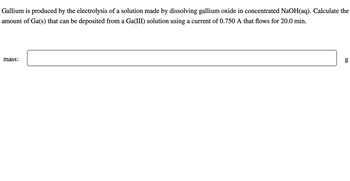
Chemistry
10th Edition
ISBN: 9781305957404
Author: Steven S. Zumdahl, Susan A. Zumdahl, Donald J. DeCoste
Publisher: Cengage Learning
expand_more
expand_more
format_list_bulleted
Concept explainers
Question

Transcribed Image Text:Gallium is produced by the electrolysis of a solution made by dissolving gallium oxide in concentrated NaOH(aq). Calculate the
amount of Ga(s) that can be deposited from a Ga(III) solution using a current of 0.750 A that flows for 20.0 min.
mass:
g
Expert Solution
This question has been solved!
Explore an expertly crafted, step-by-step solution for a thorough understanding of key concepts.
This is a popular solution
Trending nowThis is a popular solution!
Step by stepSolved in 3 steps

Knowledge Booster
Learn more about
Need a deep-dive on the concept behind this application? Look no further. Learn more about this topic, chemistry and related others by exploring similar questions and additional content below.Similar questions
- Gallium is produced by the electrolysis of a solution made by dissolving gallium oxide in concentrated NaOH(aq). Calculate the amount of Ga(s) that can be deposited from a Ga(III) solution using a current of 0.430 A that flows for 40.0 min. mass:arrow_forwardGallium is produced by the electrolysis of a solution made by dissolving gallium oxide in concentrated NaOH(aq). Calculate the amount of Ga(s) that can be deposited from a Ga(III) solution using a current of 0.490 A that flows for 50.0 min. mass:arrow_forward1.A metal "X" is used as a “sacrificial” anode on hulls of salt water vessels made of iron. The effect is to reverse the oxidation of iron to iron (II) by causing X to oxidize to the X ion. Calculate the voltage (in V, to two decimal places) for this reaction if it takes place under standard conditions. The standard reduction potential for X is -0.52 V (minus 0.52 V). 2.Batteries are charged and discharged due to the concentration of the solutions inside. Calculate the voltage of a battery made from zinc in a 0.1M solution of Zn2+ and a metal X in a 1 M X2+ solution using the table of reduction potentials and Eq. 6 at 25 degrees C. Answer with the unit V, to two decimal places. The standard reduction potential of X is -0.46 volts.arrow_forward
- What period of time (in hours) is required to produce 1.00mol of chlorine using a current of 5.00A?arrow_forwardA current of 3.21 A is passed through a Pb(NO3)2 solution. How long, in hours, would this current have to be applied to plate out 7.50 g of lead?arrow_forwardA current of 3.68 A is passed through a Sn(NO3)2 solution. How long, in hours, would this current have to be applied to plate out 5.40 g of tin?arrow_forward
- What volume of CL2 at 1 atm, 25 Co would be produced from the electrolysis of molten NaCl for 10 hours at 7 Amps?arrow_forwardGallium is produced by the electrolysis of a solution made by dissolving gallium oxide in concentrated NaOH(aq). Calculate the amount of Ga(s) that can be deposited from a Ga(III) solution using a current of 0.540 A that flows for 50.0 min.arrow_forwardCalculate the mass in grams of zinc that will deposit on a metal washer if a current of 25.0 A is applied for 4.31 hours through a Zn2+(aq) solution.arrow_forward
arrow_back_ios
arrow_forward_ios
Recommended textbooks for you
 ChemistryChemistryISBN:9781305957404Author:Steven S. Zumdahl, Susan A. Zumdahl, Donald J. DeCostePublisher:Cengage Learning
ChemistryChemistryISBN:9781305957404Author:Steven S. Zumdahl, Susan A. Zumdahl, Donald J. DeCostePublisher:Cengage Learning ChemistryChemistryISBN:9781259911156Author:Raymond Chang Dr., Jason Overby ProfessorPublisher:McGraw-Hill Education
ChemistryChemistryISBN:9781259911156Author:Raymond Chang Dr., Jason Overby ProfessorPublisher:McGraw-Hill Education Principles of Instrumental AnalysisChemistryISBN:9781305577213Author:Douglas A. Skoog, F. James Holler, Stanley R. CrouchPublisher:Cengage Learning
Principles of Instrumental AnalysisChemistryISBN:9781305577213Author:Douglas A. Skoog, F. James Holler, Stanley R. CrouchPublisher:Cengage Learning Organic ChemistryChemistryISBN:9780078021558Author:Janice Gorzynski Smith Dr.Publisher:McGraw-Hill Education
Organic ChemistryChemistryISBN:9780078021558Author:Janice Gorzynski Smith Dr.Publisher:McGraw-Hill Education Chemistry: Principles and ReactionsChemistryISBN:9781305079373Author:William L. Masterton, Cecile N. HurleyPublisher:Cengage Learning
Chemistry: Principles and ReactionsChemistryISBN:9781305079373Author:William L. Masterton, Cecile N. HurleyPublisher:Cengage Learning Elementary Principles of Chemical Processes, Bind...ChemistryISBN:9781118431221Author:Richard M. Felder, Ronald W. Rousseau, Lisa G. BullardPublisher:WILEY
Elementary Principles of Chemical Processes, Bind...ChemistryISBN:9781118431221Author:Richard M. Felder, Ronald W. Rousseau, Lisa G. BullardPublisher:WILEY

Chemistry
Chemistry
ISBN:9781305957404
Author:Steven S. Zumdahl, Susan A. Zumdahl, Donald J. DeCoste
Publisher:Cengage Learning

Chemistry
Chemistry
ISBN:9781259911156
Author:Raymond Chang Dr., Jason Overby Professor
Publisher:McGraw-Hill Education

Principles of Instrumental Analysis
Chemistry
ISBN:9781305577213
Author:Douglas A. Skoog, F. James Holler, Stanley R. Crouch
Publisher:Cengage Learning

Organic Chemistry
Chemistry
ISBN:9780078021558
Author:Janice Gorzynski Smith Dr.
Publisher:McGraw-Hill Education

Chemistry: Principles and Reactions
Chemistry
ISBN:9781305079373
Author:William L. Masterton, Cecile N. Hurley
Publisher:Cengage Learning

Elementary Principles of Chemical Processes, Bind...
Chemistry
ISBN:9781118431221
Author:Richard M. Felder, Ronald W. Rousseau, Lisa G. Bullard
Publisher:WILEY